All 50 states have adopted various symbols to represent their state. All have flower symbols.
Wikipedia’s List of U. S. State flowers
When did the U.S. Begin Adopting State Symbols?
A “National Garland of Flowers” created for the 1893 World’s Fair in Chicago (made of representative flowers from each state) was the inspiration for adopting official state flowers. This began a trend that led to the adoption of official state birds, state trees, and all the unique state symbols recognized today.
Alabama – camellia
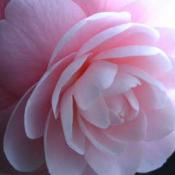 Camellias are flowering plants, evergreen shrubs, or small trees. Tea oil from Camellia’s is widely used as a cooking oil in Asia and is used to protect the blades of sharp instruments.
Camellias are flowering plants, evergreen shrubs, or small trees. Tea oil from Camellia’s is widely used as a cooking oil in Asia and is used to protect the blades of sharp instruments.
As a girl’s name, Camellia has come to represent a strong girl who always has a way to figure things out. She’ll give advice and try to help you as much as possible.
Alaska – Alpine forget-me-not
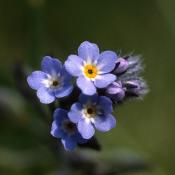
Adopted by the Territorial Legislature in 1917. It is a perennial that is found throughout Alaska. From the family Myosotis from the Greek for “mouse’s ear”. The colloquial name “Forget-me-not” was calqued from the German Vergissmeinnicht and first used in English in AD 1398 through King Henry IV of England.
Forget-Me-Not plants symbolize true love. The forget-me-not flowers are a medium, “true blue”.
The Alzheimer’s Society uses it as an icon to raise awareness for the disease and support for caretakers.
Arizona – saguaro flower
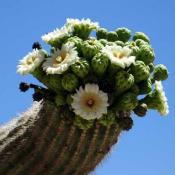
The Saguaro Cactus can reach more than 50 feet tall and live more than 200 years. It can take up to 100 years for a Saguaro cactus to grow an arm in areas of low precipitation. Arizona’s Sonoran Desert is the only place on earth where the iconic saguaro cactus grows.
The white flower blooms on the tips of the saguaro cactus during May and June. It blooms in the middle of the night and closes the next day—surviving only about 18 hours for pollination by nocturnal animals like bats and moths. The saguaro is the largest American cactus. If you cut down an endangered cactus like the Saguaro in Arizona, you could face up to a year in prison.
Arkansas – Apple Tree Blossom
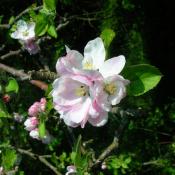
Apple blossoms are edible in small amounts but are poisonous to cats. Apple blossom is one of the most fragrant and beautiful flowered species. The Apple Blossom was adopted as the Arkansas State Flower by the General Assembly of 1901. Apple blossoms are symbolic of heady love, peace, sensuality, and fertility. Apple blossoms (and trees) were honored by the ancient Celts as a symbol of love, and they would decorate their bedchambers with these blossoms to entice amorous nights. The Apple Blossom is the state flower of Arkansas and Michigan.
California – California poppy –
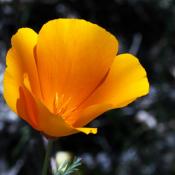
The California Poppy is a species of flowering plant native to the United States and Mexico. It is an ornamental plant flowering in summer, with showy cup-shaped flowers in brilliant shades of red, orange and yellow (occasionally pink). It is also used as food or a garnish. California poppy contains chemicals that might cause relaxation and sleepiness. It has been used for insomnia, agitation, nervous disorders.
Colorado – Columbine
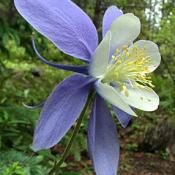
Columbine was named for the Latin word columba, which means dove. Native Americans used the seeds to make an infusion to treat headaches. The flowers of various species of columbine were consumed in moderation by Native Americans as a condiment with other fresh greens, and are reported to be very sweet, and safe if consumed in small quantities. The plant’s seeds and roots are highly poisonous however, and contain cardiogenic toxins which cause both severe gastroenteritis and heart palpitations if consumed as food.
Connecticut – Mountain Laurel
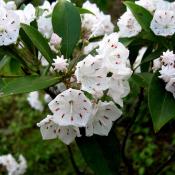
Also called the calico-bush, or spoonwood (native Americans used to make spoons from the wood), it is a broadleafed evergreen shrub in the heather family. All parts of the plant are poisonous.
Delaware – Peach Blossoms
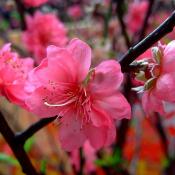
In the language of flowers, peach blossoms symbolize luck. Delaware designated the peach blossom as the official state flower symbol in 1895 because of Delaware’s reputation as “The Peach State” (at that time, Delaware orchards contained more than 800,000 peach trees).
Florida – Orange Blossom
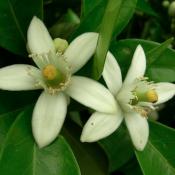
The Orange blossom is used in perfume making, has been written about as an aphrodisiac. It is traditionally associated with good fortune and has been popular in bridal bouquets and head wreaths for weddings.
Georgia – Cherokee Rose
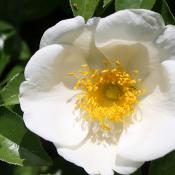
White, fragrant, climbing rose. The flower is commonly associated with the Trail of Tears, the forced relocation of Native Americans in the southeastern United States. Its white petals are said to represent the tears the Cherokee women shed during the period of great hardship and grief throughout US government-forced march from the Cherokees’ home to U.S. forts, such as Gilmer. The flower’s gold center is said to symbolize the gold taken from the Cherokee tribe.
Hawaii – yellow hibiscus
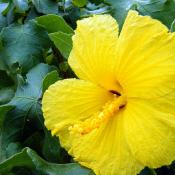
Yellow hibiscus is found only in Hawaii – it grows on all the main Hawaiian islands, but it’s extremely rare (so few remain in the wild, that it’s considered an endangered species). Hawaii changed its state flower from the native red hibiscus (Hibiscus kokio),on June 6, 1988, to the Hawaiian hibiscus – ma’o hau hele, the only species of yellow hibiscus. The flower is edible and has a tangy citrusy taste. It is a popular natural diuretic. Study shows consuming hibiscus tea lowers blood pressure. Traditionally Tahitian and Hawaiian women can wear a single hibiscus flower behind her right ear to let people know she is available for marriage. If the flower is worn behind the left ear, the woman is married or in a relationship.
Idaho – Syringa, mock orange
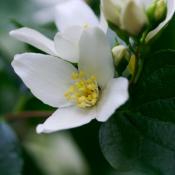
Syringa was designated the official state flower of Idaho in 1931. Syringa (Philadelphus lewisii) is a woody shrub with clusters of white, fragrant flowers (sometimes called mock orange) that grows up to 10 feet tall. The species name (lewisii) honors Meriwether Lewis (of the Lewis & Clark expedition), who wrote about the plant in his journal. This species is found only in the western states of Montana, Wyoming, Washington, and California (however, similar flowers are found under different names throughout the northern hemisphere). Native Americans found many uses for syringa; the wood was used to make pipe stems, harpoon shafts, bows, arrows, root digging sticks, and snowshoes. The bark and leaves of syringa were used to make a soap.
Illinois – violet
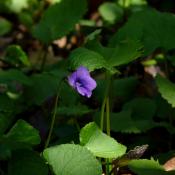
Violets typically have heart-shaped leaves. Their surface is either smooth or covered with fine hairs, depending on the species. Violet flowers symbolize delicate love, affection, modesty, faith, nobility, intuition and dignity. The meaning of the violet changes depending on the color of the flower and the person the flower is sent to. Blue violet flowers symbolizes love and faithfulness, white violets represent purity and chastity, and yellow violets symbolize high worth and goodness. One quirk of some Violets is the elusive scent of their flowers; along with terpenes, a major component of the scent is a ketone compound called ionone, which temporarily desensitises the receptors of the nose, thus preventing any further scent being detected from the flower until the nerves recover.
Indiana – Peony
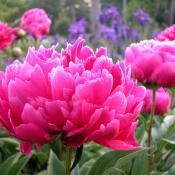
The traditional floral symbol of China, the state flower of Indiana, and the 12th wedding anniversary flower, peonies are known as the flower of riches and honor. With their lush, full, rounded bloom, peonies embody romance and prosperity and are regarded as an omen of good fortune and a happy marriage. The peony is named after Paeon (also spelled Paean), a student of Asclepius and the Greek god of medicine and healing. In Greek Mythology, when Asclepius became jealous of his pupil, Zeus saved Paeon from the wrath of Asclepius by turning him into the peony flower.
Iowa – Wild Prairie Rose
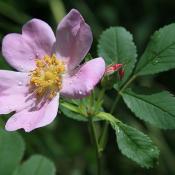
The rose is our national flower and the state flower of New York, the Cherokee rose is the state flower of Georgia, and the wild prairie rose is also the state flower of North Dakota and Iowa. The Wild Prairie Rose is not only known for its beauty but also for its medical and food uses. The rise hips and roots are used to treat inflammation of the eye. The fruit can be eaten raw or made into jellies. The stems and leaves are used in teas. Wildlife also take advantage of the wild prairie rose. Various birds, deer, antelope, elk, sheep, and pheasants feed on the rose hips. Skunks, rabbits, and gophers feed off of the fruits, stems, and foliage.
Kansas – sunflower
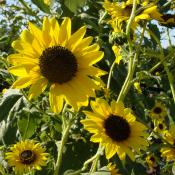
While the vibrant, strong sunflower is a recognized worldwide for its beauty, it is also an important source of food. Sunflower oil is a valued and healthy vegetable oil and sunflower seeds are enjoyed as a healthy, tasty snack and nutritious ingredient to many foods. Sunflowers also produce latex and are the subject of experiments to improve their suitability as an alternative crop for producing hypoallergenic rubber. Sunflowers may also be used to extract toxic ingredients from soil, such as lead, arsenic and uranium. They were used to remove uranium, cesium-137, and strontium-90 from soil after the Chernobyl disaster
Kentucky – Goldenrod
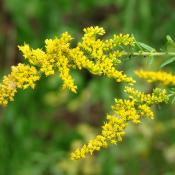
Goldenrods are considered a sign of good luck or good fortune. As a natural remedy, goldenrod has been used to reduce pain and swelling (inflammation), as a diuretic to increase urine flow, and to stop muscle spasms.
Louisiana – magnolia
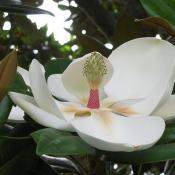
Magnolia is an ancient genus. Appearing before bees did, the flowers are theorized to have evolved to encourage pollination by beetles. A magnolia often symbolizes Yin, or the feminine side of life. White magnolias symbolize purity and dignity. Magnolia blossoms have been used to help with menstrual cramps, cough, congestion. (Pregnant women should avoid any alternative medicine including magnolia.)
Maine – White pine cone and tassel
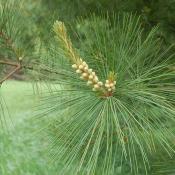
Botanically, the white pine cone and tassel are not flowers. Lawmakers chose the White Pine Cone because the state was commonly known as the Pine Tree state.
Maryland – black eyed Susan
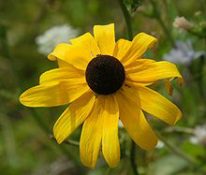
Black-Eyed Susan is a North American flowering plant in the sunflower family, Parts of the plant have nutritional value. Other parts are not edible. The roots have been used to boost immunity and fight colds, flu and infections. The species is also known to be toxic to cats when ingested.
Black-eyed Susan symbolizes encouragement and justice in the language of flowers.
Massachusetts – Mayflower
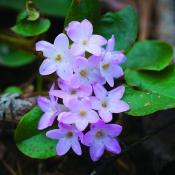
Also called Trailing arbutus is a creeping eastern North American plant, of the heath family. The Mayflower leaves contain ericoline and ursolic acid along with arbutin, which is a urinary antiseptic. At one time, Mayflowers were used to treat kidney stones.
Michigan – apple blossom
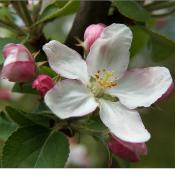
Michigan designated the apple blossom as official state flower in 1897. Michigan has been one of the leading producers of apples and apple products since those early days. Apple blossoms are edible in small amounts but are poisonous to cats. Apple blossoms are symbolic of heady love, peace, sensuality, and fertility. Apple blossoms (and trees) were honored by the ancient Celts as a symbol of love, and they would decorate their bedchambers with these blossoms to entice amorous nights. The Apple Blossom is the state flower of Arkansas and Michigan.
Minnesota – Pink/ white lady’s slipper
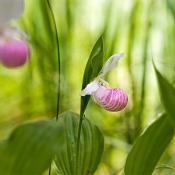
Wild native orchid. It is the state flower of Minnesota, United States, and the provincial flower of Prince Edward Island, Canada. It is illegal to pick or uproot a showy lady’s slipper flower in Minnesota. contains an irritant, phenanthrene quinone or cypripedin. The plant is known to cause dermatitis on the hands and face. Native American folklore tells the story of a young maiden who ran barefoot in the snow in search of medicine to save her tribe, but was found collapsed on the way back from her mission with swollen, frozen feet. As a result, beautiful lady slipper flowers then grew where her feet had been as a reminder of her bravery. In addition to inspiring folklore, lady slipper roots were also widely used by Native Americans as medicinal herbs.
Mississippi: Magnolia Blossom

Magnolia is an ancient genus. Appearing before bees did, the flowers are theorized to have evolved to encourage pollination by beetles. A magnolia often symbolizes Yin, or the feminine side of life. White magnolias symbolize purity and dignity. Magnolia blossoms have been used to help with menstrual cramps, cough, congestion.
The flowers of many species are considered edible. In parts of England, the petals of M. grandiflora are pickled and used as a spicy condiment. In some Asian cuisines, the buds are pickled and used to flavor rice and scent tea. In Japan, the young leaves and flower buds of Magnolia hypoleuca are broiled and eaten as a vegetable.
(Pregnant women should avoid any alternative medicine including magnolia.)
Missouri – Hawthorn
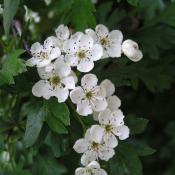
Hawthorn supports healthy circulation and cardiovascular functioning. Hawthorn leaf, flower, and berry have been praised over the centuries for their heart elevating properties. Believed to uplift and strengthen both the physical and emotional heart, hawthorn, as it supports healthy cardiovascular function, was also revered for ceremonial and spiritual purposes. The flavorful red berries have been used in candies, jams, jellies, wines, and cordials and are widely available in many forms as dietary supplements. In folklore, the story goes that Paul Bunyan used a hawthorn tree as a back scratcher.
Montana – Bitteroot flower
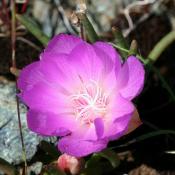
In 1805, Meriwether Lewis and William Clark “discovered” the plant in the western Montana valley that now bears its name. The roots were consumed by tribes such as the Shoshone and the Flathead Indians as an infrequent delicacy. Traditionally, the Ktunaxa cooked bitterroot with grouse. For the Ktunaxa, bitterroot is eaten with sugar; other tribes prefer eating it with salt. The Lemhi Shoshone believed the small red core found in the upper taproot had special powers, notably being able to stop a bear attack.
Nebraska – Goldenrod
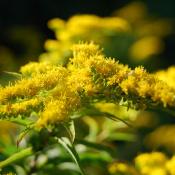
Goldenrods are considered a sign of good luck or good fortune. As a natural remedy, goldenrod has been used to reduce pain and swelling (inflammation), as a diuretic to increase urine flow, and to stop muscle spasms.
Nevada – Sagebrush
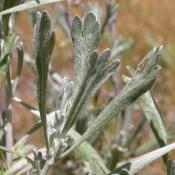
Sagebrush has a strong pungent fragrance, especially when wet. Native Americans used the leaves of sagebrush for medicine and sagebrush bark for weaving mats.
When a sagebrush plant is attacked by predators like insects, the plant emits volatile organic compounds that neighboring sagebrush plants can sense and react to by producing defensive chemicals that make them unattractive, or even poisonous, to the attackers. And other plants, like wild tobacco, can eavesdrop on this and ramp up their own defenses, significantly lowering damage from feeding animals.
New Hampshire – purple lilac
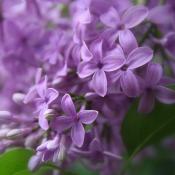
White lilacs symbolize purity and innocence. Violet lilacs symbolize spirituality. Blue lilacs symbolize happiness and tranquility. Magenta lilacs symbolize love and passion. Lilac, the color for which this flower is named, is a light purple that symbolizes a first love. the purple lilac was chosen as the state flower of New Hampshire because it symbolizes the hardy character of the men and women of the Granite State.
A lilac bush can live for hundreds of years. There are over 1,000 varieties of lilacs in several colors including white and pink. Originally from Europe and Asia, lilacs date back to the 1750’s in America – they were planted in our first botanical gardens and both George Washington and Thomas Jefferson grew lilacs in their gardens. New York recognizes lilac as the official state bush.
New Jersey – Wood Violet
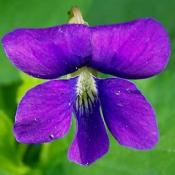
Violets typically have heart-shaped leaves. Their surface is either smooth or covered with fine hairs, depending on the species. Violet flowers symbolize delicate love, affection, modesty, faith, nobility, intuition and dignity. The meaning of the violet changes depending on the color of the flower and the person the flower is sent to. Blue violet flowers symbolizes love and faithfulness, white violets represent purity and chastity, and yellow violets symbolize high worth and goodness. One quirk of some Violets is the elusive scent of their flowers; along with terpenes, a major component of the scent is a ketone compound called ionone, which temporarily de-sensitizes the receptors of the nose, thus preventing any further scent being detected from the flower until the nerves recover.
New Mexico – Yucca flower
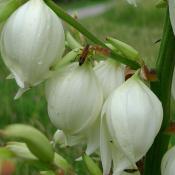
The leaves of the Yucca, New Mexico’s state flower, can be used to make rope, baskets and sandals. Seeing these lovely flowers in abundance on the plains and deserts of New Mexico, early settlers called them “our Lord’s candles.” The roots of yucca glauca (or soapweed yucca) were also found to be an excellent substitute for soap and shampoo, as was yucca elata (commonly called “soaptree yucca”).
Yuccas have a unique, specialized pollination system. They are pollinated by the yucca moth, which carefully and deliberately transfers the pollen from the stamens of one plant to the stigma of another, and at the same time lays an egg in the flower. The moth larvae then consumes a small amount of the developing seeds.
Many yuccas have edible parts, including fruits, seeds, flowers, stems, and sometimes the roots. Dried yucca wood has the lowest ignition temperature of any wood, which makes it desirable for starting fires.
New York – Rose
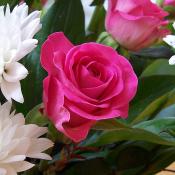
The rose is our national flower and the state flower of New York, the Cherokee rose is the state flower of Georgia, and the wild prairie rose is also the state flower of North Dakota and Iowa. The rose is a symbol of love and beauty (as well as war and politics) the world over. Red rose is a symbol of love, yellow of friendship, orange of enthusiasm, white of purity and pink of joy. We usually call the sharp spikes on the stem of a rose bush “thorns”. But these are in fact technically prickles.
North Carolina – Flowering Dogwood
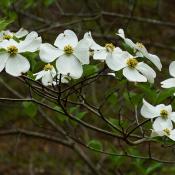
The term “dogwood winter”, in colloquial use in the American Southeast, is sometimes used to describe a cold snap in spring, presumably because farmers believed it was not safe to plant their crops until after the dogwoods blossomed. According to legend, Jesus Christ was crucified on a dogwood cross, after which God declared that dogwoods would again never grow tall enough for the construction of crucifixion crosses
One of the most interesting dogwood tree facts is that their roots are used to make dyes. There are several species of dogwood, the roots of which provide different color dyes. Specifically, dogwood roots provide red, black and yellow dyes. Additional colors can be created by mixing dogwood root with other plants that provide dyes. The wood from dogwood trees was previously used in the construction of wheels, weaving shuttles, hay forks and machine bearings. This is largely due to the fact that wood from the dogwood tree resists splitting, and wears smoothly and evenly. The wood is strong, dense, durable, and shock resistant. For these reasons, this particular wood is still used in the manufacture of items such as golf club heads, walking canes, tool handles, spindles and mallet heads.
Almost all parts of dogwood trees can be used for medicinal purposes: the bark, roots, berries, twigs, leaves and flowers. Native Americans used the root of dogwood trees to treat malaria. The inner bark of the roots contains the alkaloid known as cornin. Other ailments that have been treated with dogwood include insomnia, asthma, fevers, muscular problems, whooping cough, toothache and even canine mange. When supplies of quinine ran low during the Civil War, dogwood extract was used as a substitute.
North Dakota – Wild Prairie Rose
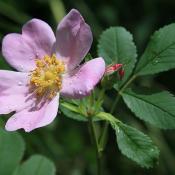
The rose is our national flower and the state flower of New York, the Cherokee rose is the state flower of Georgia, and the wild prairie rose is also the state flower of North Dakota and Iowa. The Wild Prairie Rose is not only known for its beauty but also for its medical and food uses. The rise hips and roots are used to treat inflammation of the eye. The fruit can be eaten raw or made into jellies. The stems and leaves are used in teas. Wildlife also take advantage of the wild prairie rose. Various birds, deer, antelope, elk, sheep, and pheasants feed on the rose hips. Skunks, rabbits, and gophers feed off of the fruits, stems, and foliage.
Ohio – Scarlet Carnation
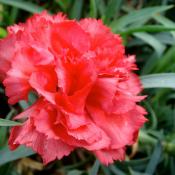
It was well-known that William McKinley, the 25th president, liked to keep a red carnation in his lapel—in fact, he gave one away to a little girl just minutes before he was shot in 1901. To honor the assassinated president, Ohio voted to make McKinley’s iconic scarlet carnation the official state flower.
Oklahoma – Oklahoma rose
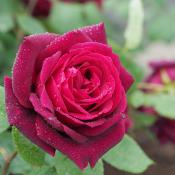
The rose is our national flower and the state flower of New York, the Cherokee rose is the state flower of Georgia, and the wild prairie rose is also the state flower of North Dakota and Iowa. The Oklahoma rose is a hybrid dark red with a strong and sweet fragrance. When it comes to floral symbols, just one flower is not enough for the people of Oklahoma! The Sooner state was already represented by two plants when lawmakers added a third because the others were considered not “cultivated” enough. One, the Indian Blanket, is a wildflower. The other, Mistletoe, is a parasite. So when more than 180 gardening clubs lobbied to add the Oklahoma Rose as a third, lawmakers acquiesced. It became the official Oklahoma state flower in 2004.
Oregon – Oregon grape
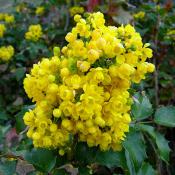
The flowers, borne in dense clusters in late spring, are yellow, and are followed by spherical dark dusty blue berries, which give rise to the common name “Oregon grape”. The inner bark of the larger stems and roots of Oregon-grape yields a yellow dye; the berries give purple dye.
Pennsylvania – Mountain Laurel

Also called the calico-bush, or spoonwood (native Americans used to make spoons from the wood), it is a broadleaved evergreen shrub in the heather family. All parts of the plant are poisonous.
Rhode Island – violet
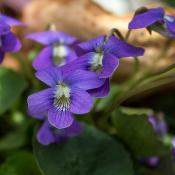
Violets typically have heart-shaped leaves. Their surface is either smooth or covered with fine hairs, depending on the species. Violet flowers symbolize delicate love, affection, modesty, faith, nobility, intuition and dignity. The meaning of the violet changes depending on the color of the flower and the person the flower is sent to. Blue violet flowers symbolizes love and faithfulness, white violets represent purity and chastity, and yellow violets symbolize high worth and goodness. One quirk of some Violets is the elusive scent of their flowers; along with terpenes, a major component of the scent is a ketone compound called ionone, which temporarily desensitises the receptors of the nose, thus preventing any further scent being detected from the flower until the nerves recover.
South Carolina – Carolina Yellow Jessamine
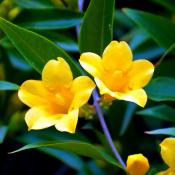
Yellow jessamine (Gelsemium sempervirens) became our official state flower in March 14,1924. Because it is native to our state, it is also called Carolina jessamine. Other names include trumpet vine, evening trumpet flower, and both yellow jasmine and Carolina Jasmine. (Jessamine and jasmine are two variations of the same word, and both are acceptable and accurate names for this plant. Here we refer to it as jessamine since that is how it is spelled in Joint Resolution No. 534, which established the flower as an emblem of South Carolina nearly a century ago.)
Jessamine is an evergreen vine that climbs trees, fences, and latticework all over our state. It blooms in very late winter or early spring, offering the first hope of warm weather to come! This flower loves sun and can grow quite fast given plenty of space and moist, well-drained soil.
When the US Mint decided to release quarters for each of the states, it was decided that Yellow Jessamine would appear on South Carolina’s quarter, along with the palmetto tree and the Carolina Wren (our state bird).
Important* – Although jessamine’s delicate, funnel-shaped blossoms are beautiful and fragrant, these flowers are poisonous! Touching them can produce an allergic reaction, and eating them can be fatal. Be careful not to mistake them with flowers such as honeysuckle, which contain a sweet and unharmful nectar.
South Dakota – Pasque flower
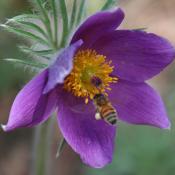
Is the provincial flower of Manitoba, Canada and the state flower of South Dakota. Also known as Pulsatilla, it is highly toxic, and produces cardiogenic toxins and oxytoxins which slow the heart in humans. Excess use can lead to diarrhea, vomiting and convulsions,[6] hypotension and coma. It has been used as a medicine by Native Americans for centuries. Blackfoot Indians used it to induce abortions and childbirth. Pulsatilla should not be taken during pregnancy nor during lactation. Extracts of Pulsatilla have been used to treat reproductive problems such as premenstrual syndrome and epididymitis. Additional applications of plant extracts include uses as a sedative and for treating coughs. The Pasque flower is useful in treating eye diseases like cataracts.
Tennessee – Tennessee Iris
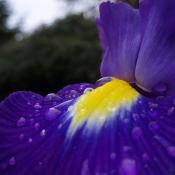
The astringent rhizome of Iris has diuretic, purgative and emetic properties. Iris flowers appear on the Tennessee license plate. They are also the subject of one of the state’s official songs (“When It’s Iris Time in Tennessee.”) And each spring, residents from Chattanooga to Knoxville gather for the state’s annual Iris Festival which honors the Tennessee state flower with a rodeo, a floral show and coronation of (what else) an Iris queen. It takes its name from the Greek word for a rainbow, which is also the name for the Greek goddess of the rainbow, Iris.
Texas – Blue Bonnets
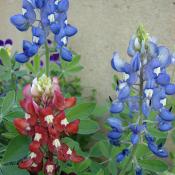
The shape of the petals on the flower resembles the bonnet worn by pioneer women to shield them from the sun. As an extension of Lady Bird Johnson’s efforts at highway beautification in the United States (see Highway Beautification Act), she encouraged the planting of native plants along Texas highways after she left the White House. Bluebonnet blooms are now a common sight along these highways in the springtime. They serve as a popular backdrop for family photographs, and the Department of Public Safety issues safety recommendations with regard to drivers pulling off highways to take such pictures. While people flock to fields of wildflowers for photo shoots, there are dangers hiding behind those pretty petals. If ingested, bluebonnets are poisonous, so be careful to keep them out of the reach of kids. And while everyone in Texas “knows” that it is against the law to pick the flowers, there’s actually no law on the books making it illegal.
Utah – Sego lily
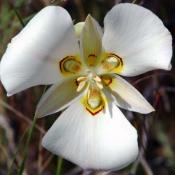
The sego lily was chosen as the flower symbol of Utah because of its natural beauty and historic significance (the soft, bulbous root of the sego lily was collected and eaten in the mid 1800’s during a crop-devouring plague of crickets in Utah). Also called mariposa lily, the bulb of the sego lily was roasted, boiled, or made into a porridge by native Americans before the Mormon pioneers.
Vermont – Red Clover
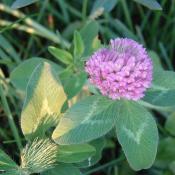
Red Clover is an herb that belongs to the legume family. It is widely grown as a fodder crop, valued for its nitrogen fixation, which increases soil fertility. In folk lore, red clover has many benefits including reduction of hot flashes and bone loss. It is the national flower of Denmark and the state flower of Vermont.
Virginia – American dogwood
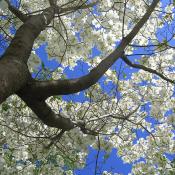
The term “dogwood winter”, in colloquial use in the American Southeast, is sometimes used to describe a cold snap in spring, presumably because farmers believed it was not safe to plant their crops until after the dogwoods blossomed. According to legend, Jesus Christ was crucified on a dogwood cross, after which God declared that dogwoods would again never grow tall enough for the construction of crucifixion crosses
One of the most interesting dogwood tree facts is that their roots are used to make dyes. There are several species of dogwood, the roots of which provide different color dyes. Specifically, dogwood roots provide red, black and yellow dyes. Additional colors can be created by mixing dogwood root with other plants that provide dyes. The wood from dogwood trees was previously used in the construction of wheels, weaving shuttles, hay forks and machine bearings. This is largely due to the fact that wood from the dogwood tree resists splitting, and wears smoothly and evenly. The wood is strong, dense, durable, and shock resistant. For these reasons, this particular wood is still used in the manufacture of items such as golf club heads, walking canes, tool handles, spindles and mallet heads.
Almost all parts of dogwood trees can be used for medicinal purposes: the bark, roots, berries, twigs, leaves and flowers. Native Americans used the root of dogwood trees to treat malaria. The inner bark of the roots contains the alkaloid known as cornin. Other ailments that have been treated with dogwood include insomnia, asthma, fevers, muscular problems, whooping cough, toothache and even canine mange. When supplies of quinine ran low during the Civil War, dogwood extract was used as a substitute.
Washington – Coast Rhododendron
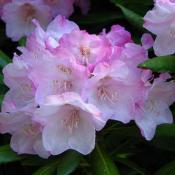
An evergreen shrub. Coast Rhododendron leaves and flowers contain toxic substances and should not be taken by humans or animals. People have been known to become ill from eating honey made by bees feeding on rhododendron and azalea flowers. Rhododendron is extremely toxic to horses, with some animals dying within a few hours of ingesting the plant. In the language of flowers, the Rhododendron symbolizes danger and to beware.
West Virginia – rhododendran
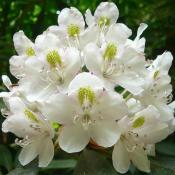
Rhododendron leaves and flowers contain toxic substances and should not be taken by humans or animals. The toxin can cause very low blood pressure and heart rate as well as irregular heart rhythm. People have been known to become ill from eating honey made by bees feeding on rhododendron and azalea flowers. Rhododendron is extremely toxic to horses, with some animals dying within a few hours of ingesting the plant. In the language of flowers, the Rhododendron symbolizes danger and to beware.
Wisconsin – Wood Violet
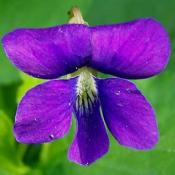
Violets typically have heart-shaped leaves. Their surface is either smooth or covered with fine hairs, depending on the species. Violet flowers symbolize delicate love, affection, modesty, faith, nobility, intuition and dignity. The meaning of the violet changes depending on the color of the flower and the person the flower is sent to. Blue violet flowers symbolizes love and faithfulness, white violets represent purity and chastity, and yellow violets symbolize high worth and goodness. One quirk of some Violets is the elusive scent of their flowers; along with terpenes, a major component of the scent is a ketone compound called ionone, which temporarily desensitises the receptors of the nose, thus preventing any further scent being detected from the flower until the nerves recover
Wyoming – Indian Paintbrush
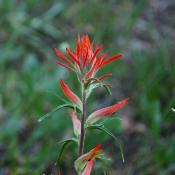
The flowers of Indian paintbrush are edible, and were consumed in moderation by various Native American tribes as a condiment with other fresh greens. Indian paintbrush has similar health benefits to consuming garlic if only the flowers are eaten in small amounts and in moderation.
